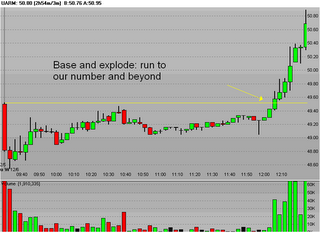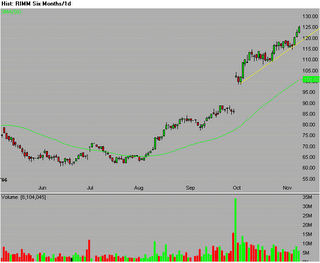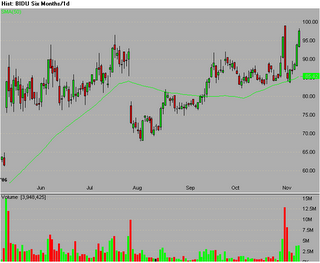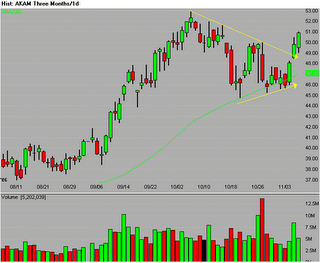We’re actually very new to the world of blogs. Call us lazy or ignorant, but we only started reading blogs about 6 months ago. OK, you can stop laughing now. Up until now we've kept to ourselves and the topics covered in our blog thus far have been focussed exclusively on our trading: stocks, our system, our methodology, all mostly isolated and not really related to the material written in other blogs. As said, we've kept out of it and stayed in our own corner. This post will be slightly different as there are a couple issues which lately we have found annoying and worth addressing, and with this post we dip our virgin pen into the ink of blog politics.
However, let's start with the positive. Over this period of time we’ve been very impressed by the breadth of knowledge of many blogwriters, but even more so by the camaraderie and generosity shown by our colleagues. Let us give you an example. We started up this little business 6 months ago called Highchartpatterns.com. Now as you also very likely know, there’s a lot of competition out there in the newsletter business, and for the most part the commercial sector of advisory services, such as the one we partake in, is not one in which people try to help each other; in fact, one of the main goals is to take customers away from each other in order to achieve supremacy. Anyway, this weekend we received an email from a very cool fellow called Declan Fallon who runs
Fallond Picks, a swing-trade service. Declan wrote to us about how he visited our website and how he had a few recommendations (for example, he said that we might think about changing the font/color of our text as it blended in too much with the background – something we changed the day after thanks to his advice). He basically introduced himself and wished us the best and great success. Now to repeat, this guy is our competition! Where in the world do you find such class and genorisity in the corporate world? We highly respect this; we are not only superstitious (like many traders) but we are also believers of karma -- and to the best of our admitted limited capacity, we also try to emulate these noble traits. The blogosphere seems to exhibit many positive features, and appears to be still more grass-roots oriented. To a certain extent it still shuns that world that most likely will ultimately envelop it, as the cannibalization of capitalism leaves few stones unturned.
This brings us to the subject of ads. Recently we have read in several sites people commenting in a negative way on blogs that have ads with the implication that if these blog-writers were "better traders" then they would not need revenue from ads. To us, this is completely ridiculous. Why in the world would people expect something for free? One can only guess at the amount of hours
Charles Kirk dedicates to his website (even though he doesn’t have ads, he asks for donations in order to enter his Member area), or the time and labor necessary to provide the incredible education you can find on
TraderMike’s blog. The amount of work that Mike has put into his blog over the years is unbelievable, and yet we read a derogatory comment a few weeks ago on the ads on his site. Come on. Did Mike go through some religious experience at a young age in which he promised his God that he would serve the people with hours of his time for absolutely no reward?
Richard has come up with his own unique scan formula that spits out great trading candidates every day; and now he even generously allows others to post on his site, would you begrudge him the bit of lunch money that he makes through his ads? Why can’t he get himself a nice steak dinner from his AdSense money, or even better, get himself a couple massages once in a while? Doesn’t he deserve it?
Our friend at
Knight Trader, who has a style of trading very similar to ours, offers a great blog (and we have no idea how he has the time for it during the trading day) in which he lists, in real-time, stocks that are showing momentum. His blog has ads. Good for you, and we hope you make a mint.
Ugly’s blog improves on a daily basis – the humor and education one finds in his blog makes it addictive. We can’t go a day without reading Ugly. He’s innovative and smart and obviously spends a lot of time making his blog one of the best out there. And we hope your ads buy you many many
boxes of wine, buddy.
Dave at
StockTickr offers a fantastic service, mostly for free, and if you want the full features, you sign-up for the Pro version for a nominal fee. Shame on you, Dave, for wanting to charge $10 a month per subscriber for the hundreds of hours you put into your business every month! Yes, of course, we’re kidding and we think his business plan is great. While we’re on that note, of course,
Trade Ideas should be free too…
If you choose not to place ads on your site, great. We ourselves don’t have any ads, but we have absolutely no ethical issue against it, the only reason we don’t is, well, we can’t really be bothered, and two, we don’t have the traffic to really pull in any decent money (remember everything is divided into three here at HCPG HQ). But if we had the traffic that would pull in a couple G each every month, for doing no extra work, would we? Of course! Why in the world would we give that up? That money could go towards the future education of our children, it could go to our favorite charities, or it could go towards a vacation – what is the moral issue against not being paid for your work? Is there an unwritten rule that one should not be compensated for one’s work on the Internet?
The same applies to membership fees. We charge $37.50 a month for our newsletter that comes out five times a week. Undoubtedly, this means that all three of us are close to blowing our accounts, being lousy traders who can’t make a decent living off our collective two decades of professional trading and thus have been reduced to selling newsletters. Of course the same logic would apply to
Steven Cohen, who runs one of the best hedge funds of our time and who also incidentally charges one of the highest fees of all hedge funds. He should really do it for free. Come on Stevie.
Again we digress. Where were we? Oh yes, charging membership fees appears to signify lousy non-profitable trading over the years on our part. Or maybe, it could mean that we wanted to start up something that would inspire us to become better and at the same time would help others evolve into more profitable traders. Why not do it for free? Why in the world would we do it for free? What is free in life? After you finish work do you go vacuum your neighbor’s house? Our time is precious and we spend an inordinate amount of it trying to make our newsletter the best newsletter possible. Why shouldn’t we be compensated for this? The modern world thrives on division of labor. The amount of time we save our subscribers in terms of scanning for stock picks makes it their worthwhile to pay the $1.87 each weekday. Let's say we save them 45 minutes each day. How much are those 45 minutes worth? Besides, if we did do it for free (we could imagine doing the blog for free, without the newsletter), we would never feel the same motivation and responsibility in regard to the quality of our work. For all those blogs providing content ad-free, fantastic, and thank you. And for all those blogs providing content with ads, fantastic, and thank you.



























